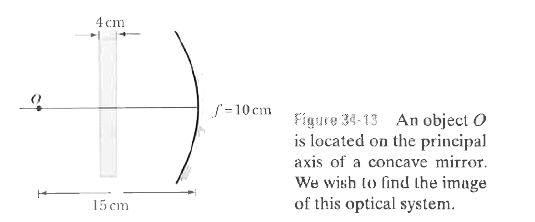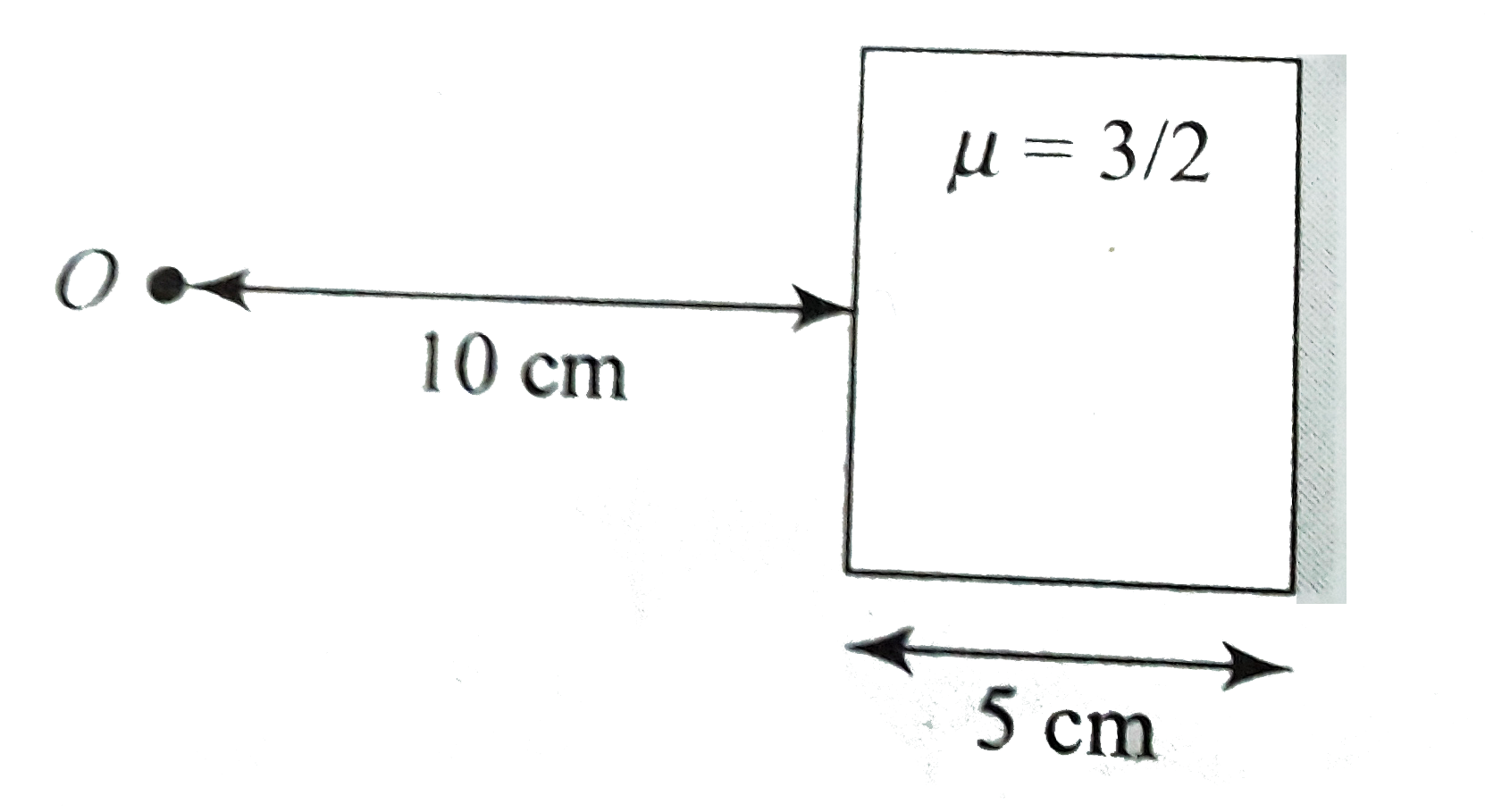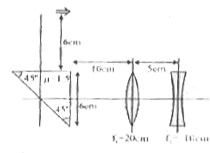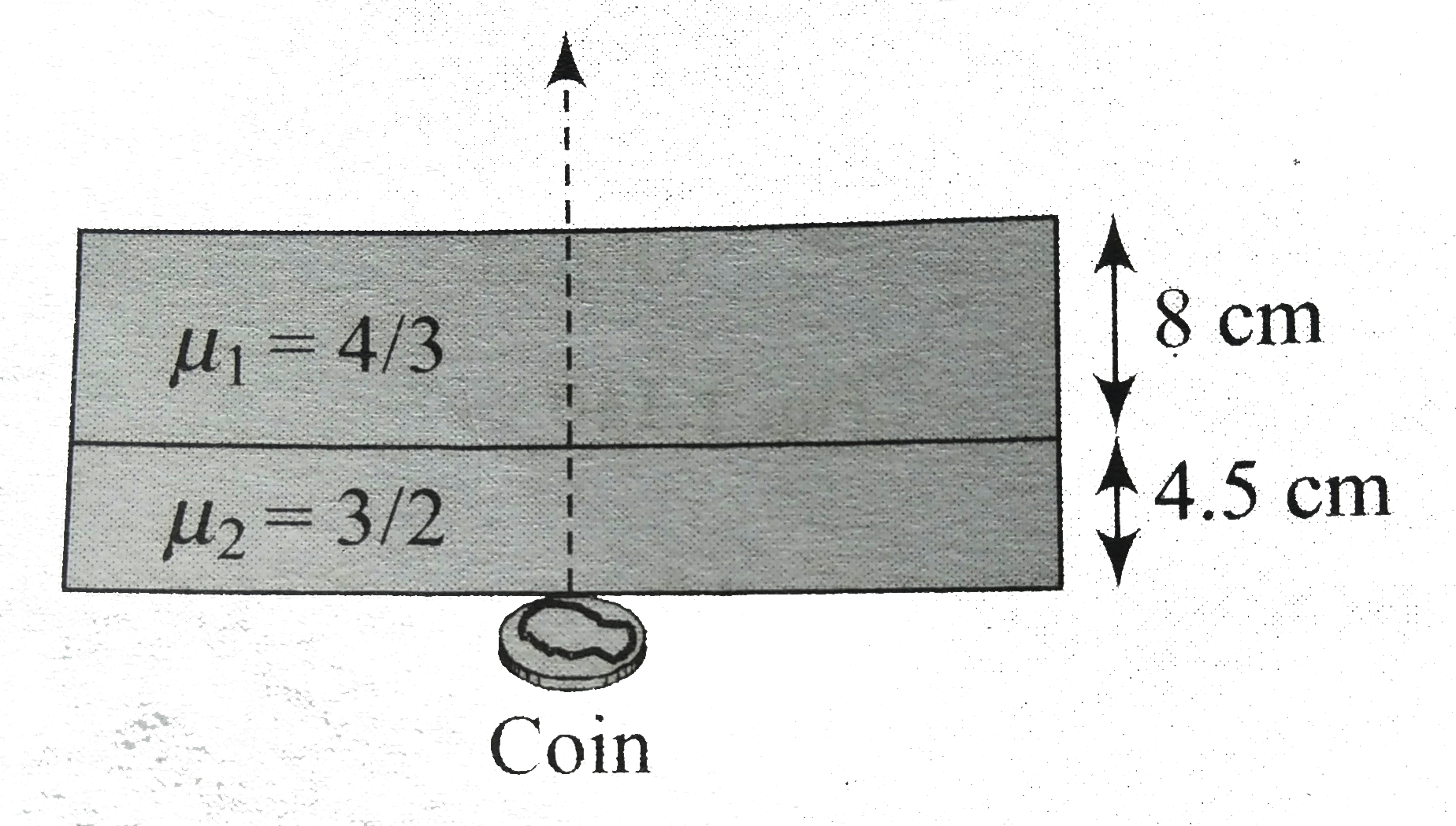Location of image after multiple events
Find the location of final image as shown in Fig.34-13. Take the refractive index of the slab as 4/3.
(1) This is again an example of multiple events before final image is formed. The rays coming from O will pass through the slab, get refracted by it and then reflected by the mirror, and again refracted by the slab. This refraction will from the final image. Whenever we refer to the image of the system, it refers to this image.
(2) The mirror will not see the object at 15cm but shifted toward it. After reflection, image will not be directly formed at the point where the mirror focuses the light but will be shifted in the direction of light incident on the slab.
Calculation : The very first event is the refraction from the glass slab. It causes a shift in the direction of the incident rays. This normal shift is given by Eq. 34-8.
x=t(1−1n)
=4×(1−34)=1cm
Thus, the object will seem to be shifted toward the mirror (in the direction of the incident rays). So, the mirror will see the object at 15−1=14cm. So, for the mirror u=−14cm . After reflection from the mirror,
v=14×1014−10=−35cm
One more time reflection will occur as light after reflecting from mirror will pass through the slab.
Again, normal shift will be 1cm, but in the direction of propagation of light. Now the light rays are propagating in the left direction. Therefore, final image will be at a distance of 36cm from the mirror.
Learn : If there are more than one slabs, the total normal shift as
Normal shift =t1[1−nn1]+t2[1−nn2]+......

Topper's Solved these Questions
- GEOMETRICAL OPTICS : REFRACTIONBOOK - RESNICK AND HALLIDAYCHAPTER - GEOMETRICAL OPTICS : REFRACTIONEXERCISE - Check point
6 Videos
- GEOMETRICAL OPTICS : REFRACTIONBOOK - RESNICK AND HALLIDAYCHAPTER - GEOMETRICAL OPTICS : REFRACTIONEXERCISE - Problems
44 Videos
- GEOMETRICAL OPTICS : REFLECTION BOOK - RESNICK AND HALLIDAYCHAPTER - GEOMETRICAL OPTICS : REFLECTION EXERCISE - PRACTICE QUESTIONS (Integer Type)
3 Videos
- GRAVITATIONBOOK - RESNICK AND HALLIDAYCHAPTER - GRAVITATIONEXERCISE - PRACTICE QUESTIONS (INTEGER TYPE)
4 Videos
Similar Questions
Formation of image by a combination of converging and a diverging lens
Find the location of the final image after all the refrections in Fig. 34-41. The radius of both the plano-convex lens and plano-concave lens is 10cm and refrective index is 1.5.
View SolutionLocate the image formed by refraction in the situation shown in figure

View Solution
Knowledge Check
A point is placed in front of thick plane mirror as shown in figure. Find the location of final image w.r.t. object.
 A15/2cmB15cmC40/3cmD80/3cm
A15/2cmB15cmC40/3cmD80/3cm
Locate the image formed by refraction in the situation shown in figure

View SolutionApparent distance of the image formed by a concave mirror dipped in water
Find the location of the final image of O formed by the system (Fig. 34-8). Assume that O is on the principal axis of the concave mirror.
View SolutionFor the combination of one prism and 2 lenses shown in figure, the size of the final image (in mm) = 0.5n. When the object (of length 1 cm) is located as shown in the figure. Refractive index of material from which prism is made is p = 1.5. Find the value of n

View SolutionLateral displacement of ray passing through a glass slab
A ray of light is incident on a parallel sided glass slab of refractive index n and thickness t as shown in Fig. 34-2. Find the lateral displacement of the ray as it passes through the slab.
View SolutionIn Fig., determine the apparent shift in the position of the coin. Also, find the effective refractive index of the combinatino of the glass and water slab.

View SolutionIn Fig., determine the apparent shift in the position of the coin. Also, find the effective refractive index of the combinatino of the glass and water slab.

View SolutionA point is placed in front of thick plane mirror as shown in figure. Find the location of final image w.r.t. object.

View Solution
